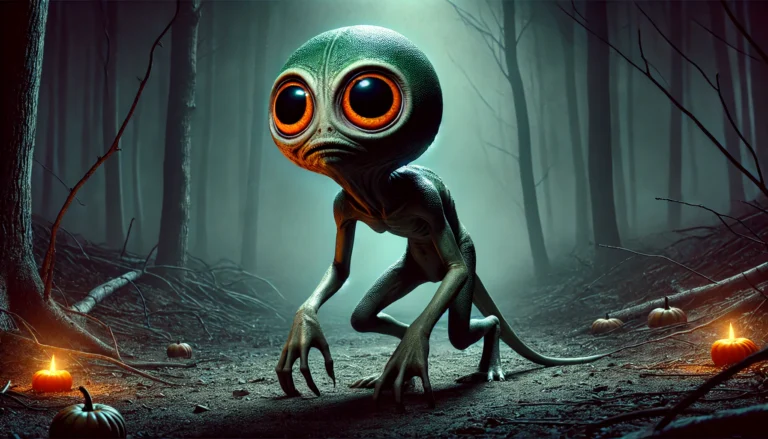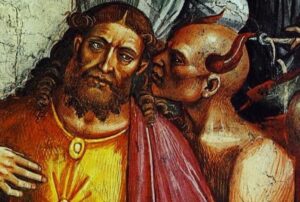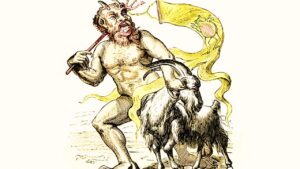Table of Contents
The Dover Demon is one of the most enigmatic and eerie creatures in the realm of cryptozoology. First reported in the small town of Dover, Massachusetts, in the United States, this creature has since captivated the imagination of both locals and enthusiasts of the unknown. The Dover Demon made its first appearance in the late 1970s and has continued to be a subject of fascination and speculation.
Origins
The Dover Demon was first sighted on the night of April 21, 1977, by three separate individuals: William Bartlett, John Baxter, and Abby Brabham. Each encounter occurred within a few hours and miles of each other, lending a strange consistency to their descriptions. This creature’s sudden emergence has no roots in local folklore or indigenous mythology, making it a unique phenomenon in the world of cryptids.
Appearance
Witnesses describe the Dover Demon as a small, humanoid figure, approximately 3 to 4 feet tall, with an unusually large, watermelon-shaped head. Additionally, its eyes are large, round, and orange, glowing eerily in the darkness. Moreover, the skin of the creature is described as rough and sandpaper-like, with a texture akin to that of an amphibian. Notably, the Dover Demon has long, thin limbs and slender fingers, which seem almost too delicate for its body. Furthermore, it moves in a peculiar, almost animalistic manner, often described as crawling or scrambling on all fours.
Abilities

The Dover Demon does not exhibit any overtly supernatural abilities. However, its elusive nature and the briefness of its appearances suggest a potential for stealth and an uncanny ability to avoid detection. Some speculate that the creature may possess a heightened sense of awareness or an ability to move silently through its environment. These traits, coupled with its strange, otherworldly appearance, contribute to the aura of mystery surrounding it.
Weaknesses
The limited number of sightings and interactions means we know very little about the Dover Demon’s weaknesses. Its seemingly fragile build and delicate limbs might suggest vulnerability to physical harm. However, its ability to remain hidden and avoid capture indicates a level of caution and survival instinct that makes it difficult to confront or study further.
Behavior with Humans
The Dover Demon’s interactions with humans have been minimal and fleeting. In each reported sighting, the creature appeared to be more curious than aggressive. It was observed watching the witnesses from a distance or moving away when approached. This behavior suggests that the Dover Demon might be as wary of humans as they are of it. Reports have never indicated that it attacked or harmed anyone, further adding to the mystery of its intentions and nature.
Symbols
As a relatively recent addition to the world of cryptids, the Dover Demon does not have established symbols representing it. However, its most distinctive features, such as its large, glowing eyes and oversized head, have become iconic in descriptions and artistic representations. These elements are often emphasized in illustrations, making the creature instantly recognizable.
Narrative Account

On a cold spring night in 1977, young William Bartlett was driving through the darkened streets of Dover. The quiet town was blanketed in an eerie silence, broken only by the hum of his car’s engine. As his headlights pierced the darkness, they illuminated a strange figure perched on a low stone wall. What he saw defied explanation: a small, humanoid creature with a large, bulbous head and glowing eyes that seemed to burn into his memory.
William’s heart raced as he sped away, unsure of what he had just encountered. His account, marked by genuine fear and confusion, would be the first of three sightings that night. John Baxter, walking home from his girlfriend’s house, encountered the same creature standing in the road, and Abby Brabham saw it from a distance, its eyes reflecting the light like a pair of burning coals.
These encounters, reported independently, painted a consistent picture of a creature that seemed almost too fantastical to be real. The Dover Demon, as it came to be known, was not a product of local legend or a figment of overactive imaginations. Its appearance was unprecedented, and its origins remained a mystery.
Other Creatures Sharing Similarities
The Dover Demon’s appearance and behavior share certain similarities with other cryptids and mythical creatures. For instance, its large head and eyes are reminiscent of the classic depiction of extraterrestrials, leading some to speculate about a possible alien origin. Additionally, the creature’s amphibious texture and ability to move stealthily through the night have drawn comparisons to the Lizard Man of Scape Ore Swamp, another cryptid reported in the United States.
Furthermore, the Dover Demon’s fleeting interactions with humans echo the elusive nature of creatures like the Mothman or the Jersey Devil. These entities, much like the Dover Demon, appear sporadically and vanish without a trace, leaving behind more questions than answers.
Conclusion
The Dover Demon remains one of the most compelling and mysterious figures in cryptozoology. Its brief but startling appearances in 1977 have left an indelible mark on those who encountered it and those who study the unknown. Despite the passage of time, the Dover Demon continues to intrigue and perplex, standing as a testament to the enduring allure of the unexplained.
Whether it is a creature from another world, a previously unknown species, or something entirely different, the Dover Demon challenges our understanding of the natural world.
FAQ
When and where was the Dover Demon first sighted?
The first sighting of the Dover Demon occurred on the night of April 21, 1977. A teenager named William Bartlett claimed to have seen the creature while driving along Farm Street in Dover, Massachusetts.
What does the Dover Demon look like?
Witnesses describe the Dover Demon as about 3-4 feet tall with a disproportionately large, bulbous head, glowing orange or green eyes, and no noticeable mouth, nose, or ears. Its skin is said to be rough and textured, similar to sandpaper.
Who reported sightings of the Dover Demon?
Three teenagers reported sightings of the Dover Demon over a two-day period. The witnesses were William Bartlett, John Baxter, and Abby Brabham. Each reported seeing the creature in different locations around Dover.
Are there any physical traces or evidence of the Dover Demon?
No physical evidence, such as footprints or fur, has been found to support the existence of the Dover Demon. The creature is known solely from eyewitness accounts and sketches made by the witnesses.
Has the Dover Demon been seen since 1977?
There have been no widely reported sightings of the Dover Demon since the initial incidents in 1977. The creature remains a subject of local folklore and cryptid enthusiasts.
What explanations have been proposed for the Dover Demon?
Various explanations have been proposed, ranging from misidentifications of animals such as young moose or calves to the possibility of a hoax. Some speculate that it could be an alien or an undiscovered species.
How did the Dover Demon get its name?
The creature was dubbed the "Dover Demon" by cryptozoologist Loren Coleman, who investigated the sightings shortly after they occurred. The name stuck and has been used ever since.
Is there any connection between the Dover Demon and other cryptids?
There are no direct connections between the Dover Demon and other cryptids, although its appearance and behavior have led some to compare it to other reported creatures like the Jersey Devil and the Chupacabra.




